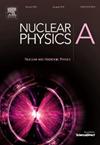Hydrodynamical model for high-energy dipole vibrations in nuclei far from the beta-stability line
IF 2.5
4区 物理与天体物理
Q2 PHYSICS, NUCLEAR
引用次数: 0
Abstract
The model for describing the isoscalar and isovector dipole giant resonance energies in nuclei with a neutron (or proton) halo or skin is presented. The realistic density distribution of the halo/skin, exponentially decaying with increasing radius, is taken into account. The proton and neutron density oscillations in the core part of the nucleus are described by the hydrodynamic equations of continuity and Euler. The proton and neutron density oscillations in the core part of the nucleus are coupled to both the proton and neutron core radii vibrations as well as the density fluctuation inside the neutron (or proton) halo/skin using the boundary conditions on the free surface. The pressure of the neutron (proton) matter related to the density oscillation in the halo/skin is evaluated using the Skyrme energy-density functional. Simple formulas are obtained for calculating the energies of dipole vibrations in nuclei with the halo/skin. It is found that the excitation energies of the isoscalar dipole resonances in the nuclei with halo/skin are smaller than those in the nuclei without halo/skin. The excitation energies of the isovector dipole resonances are weakly dependent on the halo/skin characteristics. The influence on the excitation energies of the dipole resonances of the halo/skin properties is discussed. The transition densities of the resonances are considered.
远离稳定线的原子核中高能偶极子振动的流体动力学模型
提出了描述具有中子(或质子)晕或皮的原子核的等标量和等矢量偶极子巨共振能的模型。考虑了光晕/蒙皮随半径增加而呈指数衰减的真实密度分布。用连续流体力学方程和欧拉流体力学方程描述了原子核核心部分的质子和中子密度振荡。利用自由表面的边界条件,将原子核核心部分的质子和中子密度振荡与质子和中子核心半径振动以及中子(或质子)晕/皮内的密度波动耦合起来。利用Skyrme能量密度泛函计算了与晕/皮密度振荡有关的中子(质子)物质的压力。给出了计算具有晕/皮的原子核中偶极子振动能量的简单公式。发现有晕/皮的原子核的等标量偶极子共振的激发能比没有晕/皮的原子核的激发能小。等矢量偶极子共振的激发能对晕/皮特性的依赖性较弱。讨论了光晕/趋肤性质对偶极共振激发能的影响。考虑了共振的跃迁密度。
本文章由计算机程序翻译,如有差异,请以英文原文为准。
求助全文
约1分钟内获得全文
求助全文
来源期刊

Nuclear Physics A
物理-物理:核物理
CiteScore
3.60
自引率
7.10%
发文量
113
审稿时长
61 days
期刊介绍:
Nuclear Physics A focuses on the domain of nuclear and hadronic physics and includes the following subsections: Nuclear Structure and Dynamics; Intermediate and High Energy Heavy Ion Physics; Hadronic Physics; Electromagnetic and Weak Interactions; Nuclear Astrophysics. The emphasis is on original research papers. A number of carefully selected and reviewed conference proceedings are published as an integral part of the journal.
 求助内容:
求助内容: 应助结果提醒方式:
应助结果提醒方式:


